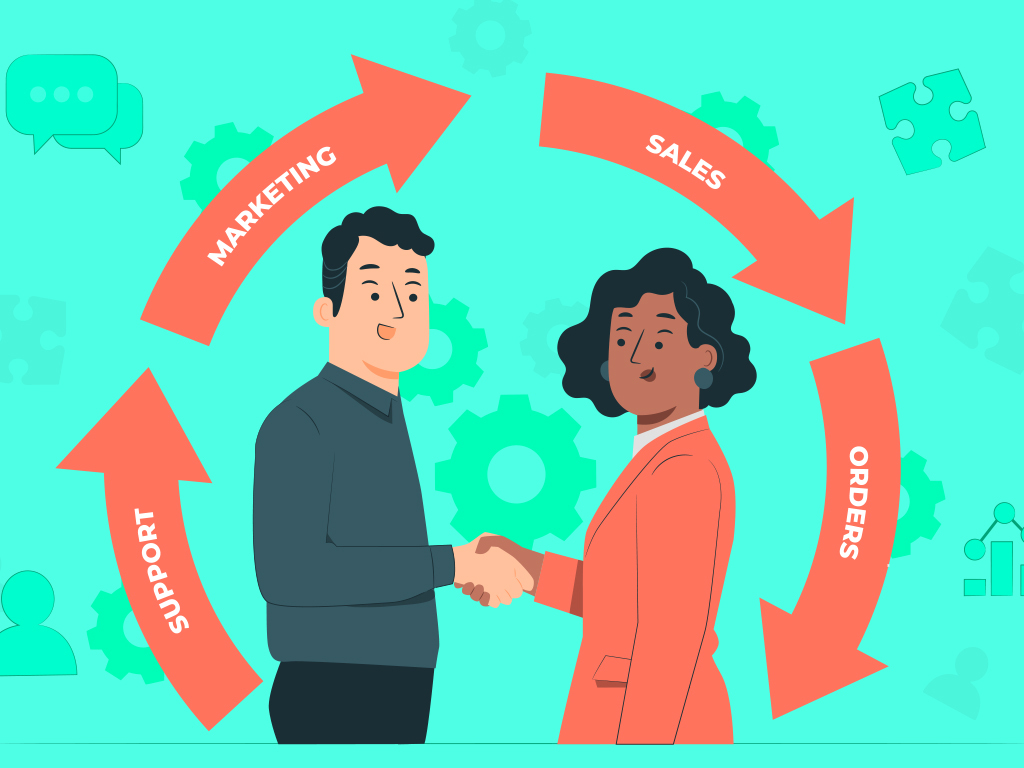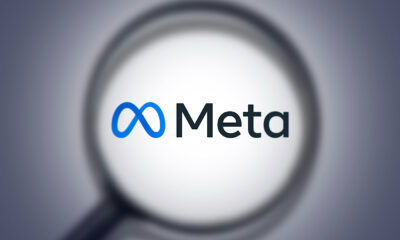SEO
What is Customer Relationship Management?

Customer relationship management (CRM) is the system that a company sets up to manage prospect and customer interactions and analyze their data to improve business relationships.
By setting up this system, the company streamlines the process of staying connected to their prospects and customers, ultimately driving up retention and sales. According to Agile CRM and Salesforce, a company can boost sales by 29% and conversion rates by up to 300% with proper CRM implementation.
This blog post is an in-depth guide on customer relationship management, how it can help your business, my software recommendations, and more.
- What a CRM system does
- How customer relationship management helps your business
- Types of CRM platforms
- My recommended CRM software
- Key takeaway
What a CRM system does
A CRM system consists of two things: a strategy and a software. Without a strategy, CRM software cannot be maximized by the marketing and sales team. Without software, managing customer relationships and doing data analysis would be nearly impossible to do especially when your customers are in the thousands.
So, what exactly does a CRM system do?
To help you visualize these functions, I will show you photos of the customer relationship management software I use: Drip.
Manages leads and customers
A customer first enters your CRM software through a sign-up for a free demo, lead magnet download, account creation, and so on and so forth. Their data then enters your chosen software and gets updated either through their actions or yours.

For example, this subscriber first entered last August 13 when they visited my website. They placed an order the following day, updated their information, then subscribed to my marketing emails.
They went through various Workflows and received my marketing emails after that, depending on the actions they took. And since they are active in engaging my emails, they also automatically got the appropriate tags and was eventually noted by Drip as a lead.
Having a CRM software then isn’t just for storing customer data, but for applying some of the strategies that the team has planned to ensure that customers will remain as such, leads will be followed up on, and opportunities for sales will be maximized.
You can also create customer segments for a more personalized approach. For example, your marketing and sales strategy towards highly engaged leads and disengaged ones would be very different. You would want to coax back disengaged ones (or prune them) and turn the highly engaged leads into sales.

Automates marketing
I mentioned above that our subscriber received my marketing emails depending on the actions they took. Instead of me or my marketing team having to check every single action of every single customer, we already discuss our strategies and ensure that we are at least one or two steps ahead of our customers.
This helps us automate tasks that can be automated, such as creating loyalty tiers for people who accumulate lifetime values. This also ensures that a marketing email is automatically sent to those who sign up for anything on our website, and follow-up emails are sent to those who purchased a product or downloaded our lead magnets.
Optimizes processes through Workflows
This is perhaps my favorite feature when it comes to customer relationship management software: Workflows.

According to Pipefy, “You can think of a CRM Workflow as a line of dominoes you need to knock over to get from an initial trigger to your desired outcome.”
As you can see, I just added a trigger (Segments), and two actions (Delay and Email). Once a day, Drip will check the segment that I selected if there are new people, and the Workflow will automatically activate for those customers.
There are multiple uses for Workflows. You can use it to add tags to users who complete your preferred actions, send warm-up and follow-up emails to your customers, create abandoned cart strategies, and so much more.
Analytics
And of course, it’s incredibly important that we are able to see the performance of our marketing and customer relationship management efforts.

Here in Drip for example, the Analytics shows different kinds of data that I may need to see to gauge how well I’m performing. Let’s say that I need to see how well my past two emails have been performing. I just need to click Email Metrics and look at my two most recent emails.

When the Analytics show me that there are issues with the emails I’m sending, then perhaps I should start shifting strategies. This is why even if a CRM software can pretty much do everything that you need it to do, it’s still up to you—the user—to come up with good strategies that will ensure your customer relationship management is as fruitful as it can be.
Streamlines processes through integration
Lastly, a CRM software makes things easier for marketing and sales teams by streamlining processes through integration of different software. Going back to our Workflow, you can see that I can choose another software and choose from the list of actions that the integration permits.
How customer relationship management helps your business
Now that you know what a CRM system does, it’s time to discuss its top benefits for your business.
Improved customer service and relations
According to SuperOffice, 74% of companies using CRM report improved customer service. This is due to the fact that data analysis, segmentation, and automation give companies the ability to personalize and better customer experience every step of the way.
And of course, if your customer’s experience of your company is positive, then relations also improve. Because of your strategy and the CRM software that you’re using, you’re able to really show up for your customers as individuals and respond to their needs.
Increased customer retention
According to Act-On, 99% of B2B top performing companies utilize CRM for customer retention. Part of improving their experience, responding to their needs, and building your relationship with your customers is understanding their preferences and resolving their issues as fast as possible. Since you have a plethora of features to choose from in a CRM software plus your strategy, you get to attend to your customers’ needs in a way that is unparalleled.
Customer relationship management also includes reaching out to customers and ensuring that they repeat purchases through recommendations, or reconnecting to older customers who may have been neglected. According to SuperOffice, keeping an existing customer is about 6 to 7 times cheaper than acquiring new ones, so that is also something to keep in mind.
Heightened productivity
Since CRM software have integrations, automations, and other features, then it takes away some load off of marketing and sales teams. According to destinationCRM, 91% of businesses with more than 10 employees in the US have a CRM system in place as it already automates repetitive tasks and other manual processes.
Imagine not having to manually encode customer emails, send follow ups one by one, and check individually if the customer is ready to purchase!
Increased ROI
Last but not the least, proper CRM implementation can eventually yield your company an ROI exceeding 245%, although the timeline is around four months to a year according to Martech Zone. But still, that’s a massive increase that is well worth the effort, especially since the increased ROI is a result of a productive marketing and sales team, and better customer relations.
Types of CRM platforms
There are three kinds of CRM platforms: Open-source CRM, on-premise CRM, and cloud-based CRM.
Open-source CRM
Open-source CRM simply means its source code is publicly available and can be “distributed, modified, and redistributed by users according to their needs.”
One major advantage of choosing an open-source CRM is the price. It’s (more often than not) free or much more affordable than their proprietary counterparts. Considering that open-source CRMs have the same functions as proprietary CRM plus an immense amount of flexibility due to its nature, many companies opt to go for open-source.
One major disadvantage of open-source CRM is implementation. Considering that it doesn’t come “boxed” unlike proprietary CRM, you need to ensure that you have developers on your team (or at least, that the product has an active developer community) to ensure that you can maximize your software and set it up properly.
On-premise CRM
On-premise CRM means that the software is running on your office servers (hence, on-premise). This means that you have to be in your office to be able to do some customer relationship management.
On-premise CRM also needs plenty of IT attention. Since it’s on-premise, the company’s team is basically in charge of every aspect of managing the CRM platform. This is also why big businesses are usually the ones that opt for this type of CRM—they have the people, the budget, and the need.
It’s not all disadvantages, though. On-premise CRM, as it’s setup and handled by the company, can be customized and configured to fit the company’s processes better. This means that the CRM can be tweaked to fit and support a specific company’s needs.
Cloud-based CRM
On the other hand, cloud-based CRM is just that—cloud-based. Unlike on-premise CRM, the only thing you really need to access the software is internet connection.
You also don’t need a full in-house IT team to manage the CRM in this case. If things go wrong, you can simply contact the vendor’s customer service and ask for their assistance.
Aside from that, it’s easy to setup and can be accessed by anyone in the team who has an account. Typically, there is one owner who can add member users to their account and set the privileges of those users.
What are the disadvantages? For one, faulty internet connection will make using a cloud-based CRM frustrating. There’s also less customization as most likely you are purchasing a “ready-to-go” type of CRM. Lastly, in the event that there’s a bug or some other issue with the platform, you will have to wait for their customer service to come up with a solution. I have had the unfortunate experience once where I came across a bug that the vendor’s team did not know how to fix, and it was a huge headache for everyone involved.
My recommended CRM software
I have two recommended customer relationship management software: Drip and Overloop.
Drip: E-commerce customer relationship management
Drip is the platform that I currently use for my company. It markets itself as an ECRM—a platform that is built for the KPIs of e-commerce. According to Drip, “With ECRM, you can see what your customers are doing all the time—what links they’re clicking, what pages they’re visiting, what emails they’re clicking through, what products they’re yearning after. ”

Then Drip’s dashboards give you a sense of where your customer is in terms of your sales funnel.
Where Drip shines is in its segmentation capabilities.

There are a plethora of filters to choose from that makes segmentation so much easier. According to their website, “You win with intimacy.”
I agree.
Overloop (formerly Prospect.io): Made for conversations
I reviewed Overloop before back when it was still Prospect.io (they changed names back in October 2021). It’s incredibly user-friendly and intuitive, and they even have an extension available in the Chrome web store that you can use to easily find prospects.

Where Overloop shines is how they center their platform on conversation. Aside from being robust in features, they also have four areas that are for connecting to and reaching out to customers: Cold Email Campaigns, Email Finder, Live Chats, and Web Forms.

Aside from that, instead of having to use different platforms to check your pipeline and your tasks, you can just use Overloop as they have all those things integrated, making it a full-fledged CRM platform.
Try Overloop with our referral code!
Key takeaway
Customer relationship management isn’t just about using a software to keep customer data, it’s a holistic strategy that includes a CRM software to ensure that your relationship and interactions with your customers are kept healthy and alive. With all the areas and features of CRM, the main benefit really is that your customers get to have a good experience with your company, inevitably increasing sales and retention.
Don’t know how to implement a CRM system for your company? You can opt to let us do it for you!
Source link





















You must be logged in to post a comment Login